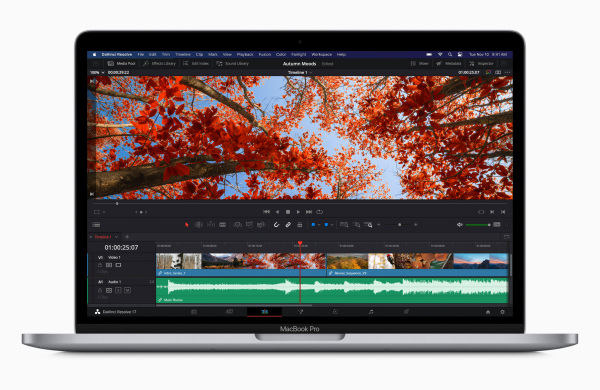[14:33 Thu,29.April 2021 by Thomas Richter] |
According to a report from Nikkei Asia, Apple has started mass production of a new version of its M1 chip this month. The new chip - presumably called M2 or M1X - could be launched in new MacBook Pro models as early as July. M1 SoC successor will be unveiled. M2/M1X coming to new MacBook Pros in June. The new M2/M1X will be manufactured by Taiwanese chipmaker TSMC using the 5 nanometer process rather than the 4 nanometer process, as was the case with the M1 chip, but using the new N5P technology, which allows for slight improvements in performance and slightly lower power consumption compared to the N5 process used in the manufacture of the M1. According to Nikkei, other devices besides the MacBook Pro will also be equipped with this new SoC -  Apple M1 MacBook Pro 13" A newly improved version of the www.slashcam.de/news/single/Neue-Apple-Hardware-mit-eigenem-M1-Chip---MacBook--16176. html (M1 chip) is also expected by analysts because this is the only way Apple can differentiate its offering from the in-house developed ARM M1 chip equipped models (i.e. the MacBook Pro 13", MacBook Air 13", Mac mini, iPad Pro and 24" iMac ) in terms of performance (and thus also price): So far, all models basically use the same SoC with 4 large and 4 small CPU cores, as well as 7 or 8 GPU cores and 8 or 16 GB of RAM, and therefore differed in their performance only rather slightly by the maximum coolable power, i.e. whether the system is actively or passively cooled. M2 or M1X: What are the innovations? But what are the improvements compared to the M1 chip? We can only speculate here - according to tweets from last November from  M1 SoC Apple&s M1 Revolution. Dubbed the M1, Apple&s chip - Apple&s most powerful ever - is a 64-bit SoC based on ARM technology similar to the A14 used in iPhones and iPads and is manufactured using 5 nanometer process technology. It integrates - unlike all previous Macs or even PCs - many functions from different chips into one, much like the SoCs of smartphones. Thus, the M1 has four performance as well as four energy-saving cores, which share the working memory, which is also on the chip, with the 8-core GPU on the same chip, which is supposed to have twice the performance of an integrated PC GPU. The integration of the RAM ("unified memory") into the M1 SoC has, besides the advantage of high speed and the shared access of CPU and GPU to it, also a disadvantage: the RAM can no longer be expanded later, since the memory is a fixed part of the SoC. The new system has an extremely high performance per watt ratio due to the tight integration of the different components and delivers the same performance as an Intel Dual Core MacBook Air. The GPU is capable of seamlessly playing multiple 4K video streams or rendering complex 3D scenes. Integrated on aChip include an image signal processor (ISP) , a Secure Enclave for secure storage of biometric data on the device; a high-performance storage controller with AES encryption hardware for faster and more secure SSD performance; highly efficient low-power media encoding and decoding engines; and an Apple-designed Thunderbolt 3 controller with support for USB 4. Here&s our review of the MacBook Pro 13" with M1 with video applications deutsche Version dieser Seite: Neuer MacBook Pro mit M2-Chip schon im Juli? |





